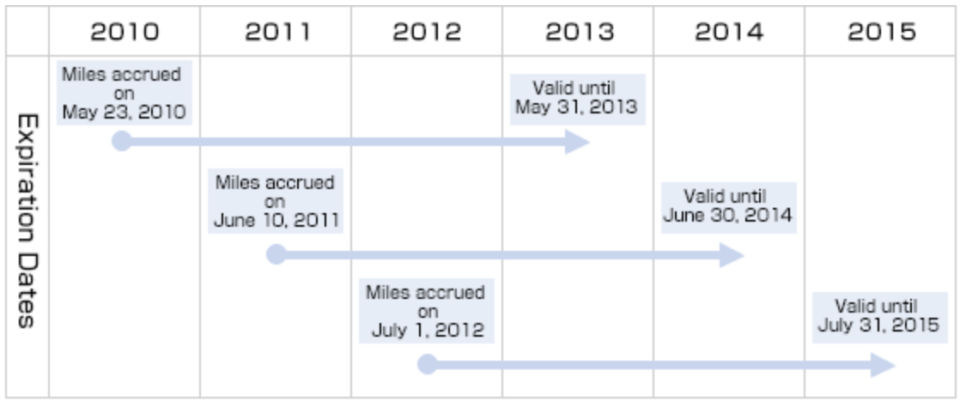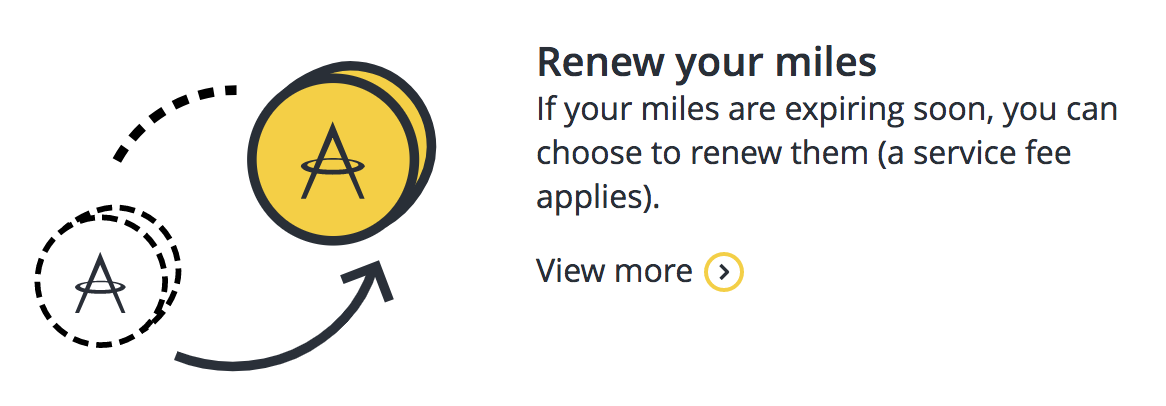You never want to find yourself in a situation where your frequent flyer miles have expired. Many people have saved up thousands or even hundreds of thousands of miles for a dream vacation. With some of the best award redemptions at the high end of the award chart, starting over from scratch is a bummer. Besides, those miles could mean real cash savings. You wouldn’t want to lose your wallet, would you?
Getting those miles back is tricky. Some programs have a flat fee or no fee at all. But most programs charge according to a sliding scale. You might pay a small amount for every mile or a fixed amount for some range of expired account balances. Some programs don’t let you get your miles back at all. Ever. So in addition to including tips for getting your miles back I’ve also described the expiration policies of each program to keep in mind before disaster strikes.
Summary of Expiration Policies
Every airline has specific expiration policies that I’ve detailed in the sections below, but for a high-level view just check out this summary. You can see that the period of validity ranges from 18 to 24 months in most cases, but it can be as short as 12 months or go on forever.
If you’re worried about your miles expiring, set a reminder on your calendar. You can write an email to yourself and schedule it to send automatically at a future date! I personally use AwardWallet to track all my accounts, including accounts owned by other family members who don’t want to deal with the hassle. If your miles have already expired, I’ve also provided some information about how to get them back.
| Airline | Program Name | Expiration |
|---|---|---|
| Air Canada | Aeroplan | 12 months w/out activity |
| Alaska Airlines | Mileage Plan | 24 months w/out activity |
| American Airlines | AAdvantage | 18 months w/out activity |
| All Nippon Airways (ANA) | Mileage Club | 36 months after earning |
| Avianca | LifeMiles | 12 months w/out earning |
| British Airways | Executive Club (Avios) | 36 months w/out activity |
| Cathay Pacific | Marco Polo Club (Asia Miles) | 36 months after earning |
| Delta Air Lines | SkyMiles | Never |
| Hawaiian Airlines | HawaiianMiles | 18 months w/out activity |
| Japan Airlines (JAL) | Mileage Bank | 36 months after earning |
| JetBlue | TrueBlue | Never |
| KLM/Air France | Flying Blue | 24 months w/out flying |
| Korean Air | SKYPASS | 10 years after earning |
| Singapore Airlines | KrisFlyer | 36 months after earning |
| Lufthansa | Miles & More | 12 quarters after earning |
| Southwest Airlines | Rapid Rewards | 24 months w/out earning |
| United Airlines | MileagePlus | 18 months w/out activity |
Air Canada (Aeroplan)
Aeroplan has a very strict policy that says miles expire after just 12 months of account inactivity. That means you need to have frequent transactions to earn or redeem miles to keep the rest of your balance from disappearing. If you do let miles expire, the cost to restore them is CAD$0.01 per mile plus a flat administrative fee of CAD$30. This is potentially very expensive. There’s no cap on the number of miles you can reinstate and no cap on the total fees, either. It might still be worthwhile, as Aeroplan miles are worth about USD$0.015 cents each.
Alaska Airlines (Mileage Plan)
Technical miles do not expire with Alaska Mileage Plan, but the program still reserves the right to close accounts that have been inactive for 24 months. Note that we’re talking about closing the entire account, not just zeroing out the balance. This means you could potentially get a grace period if Alaska doesn’t move quickly once 24 months rolls around. You can also request that Alaska reinstate your Mileage Plan account up to one year later for a very reasonable fee of $75.
American Airlines (AAdvantage)

American AAdvantage will let your miles expire after 18 months without any account activity. Miles can be reinstated for a few hundred dollars, depending on the number of miles in the account. These are a subset of the options available (and if you need to reactivate more than 500,000 miles, you can make multiple transactions).
- $40 to reinstate 1-5,000 miles
- $250 to reinstate 25,001-35,000 miles
- $500 to reinstate 50,001-75,000 miles
- $2,000 to reinstate 250,001-500,000 miles
You could also try calling AAdvantage customer service and ask about a “reengagement challenge.” This still involves a fee, but it’s lower and requires that you fly a certain number of miles depending on the number of miles you want to reactivate.
All Nippon Airways (Mileage Club)
Miles in ANA’s Mileage Club will expire 36 months after the month in which they were earned, which means you could have different miles expire at different times. Cathay Pacific and Singapore Airlines follow expiration similar policies, but unlike those two, it’s not possible to extend the life of your ANA miles by paying a fee. Three years and that’s it. The one exception is for Diamond elite members, whose miles will not expire as long as they keep that status.

Avianca (Life Miles)
LifeMiles are a popular currency because they can be bought very cheaply and can be used for award travel on a variety of Star Alliance partners. However, if you buy miles and never get around to using them, that’s painful! Current policy says LifeMiles will expire 24 months after your last account activity. If they do expire, you can reactivate them by paying USD$10 plus taxes for every 1,000 miles.
At roughly a penny per mile, this is not a cheap option. LifeMiles often go on sale for as low as 1.35 cents each. It’s unclear what Avianca wants to charge in terms of “taxes” on this transaction, so pay close attention. You may be better off leaving your miles behind and buying a new batch.
Unfortunately, as of April 15, 2018, miles will expire after just 12 months, and not just any activity will do. Only earning miles will work. If you redeem miles that you already have then the clock WILL NOT reset.
British Airways (Executive Club/Avios)
Avios, the currency of the British Airways Executive Club, will expire after 36 months of account inactivity. Although the program does not detail an official policy for reinstating miles, you may be successful if you call customer service and make a personal request. Reports from other Executive Club members say that this reinstatement sometimes came with conditions, such as booking a new flight during the next three months, to prove they were serious about keeping the account active.
You can also consider joining a Household Account. When redemptions are made by any member of a Household Account, the Avios are deducted proportionately from each member. You have to be willing to redeem some of your Avios for family members, but at least everyone else’s travel plans will help keep your account active, too.
Cathay Pacific (Asia Miles)
Asia Miles are valid for 36 months after they were earned, which means miles earned at different times will also expire at different times. There is no policy to protect the balance of the entire account. However, you can extend the validity of Asia Miles that are about to expire by paying a fee of $40 per 2,000 miles. This will push back their expiration date by 36 additional months. (If you make your request by phone, expect to pay a higher fee of $100 per 2,000 miles).

Hawaiian Airlines (HawaiianMiles)
Any earning or redemption activity in your HawaiianMiles account in the past 18 months will prevent your miles from expiring. There is no public policy on reinstating miles, but multiple reports suggest this can be done on request for a fee of $30 per 1,000 miles. This is incredibly expensive and is likely not worthwhile. Just buy the ticket with cash.
Japan Airlines (Mileage Bank)
JAL has exactly the same rules as ANA Mileage Club, in that miles expire 36 months after the month they were earned. There’s no exception for members with elite status, however, and there’s still no way to reactivate or extend their life. Mileage Bank does provide a helpful reminder that miles will expire according to the time in Japan, which means 7 AM Pacific Time (10 AM Eastern Time) on the day before the last day of the month.
KLM/Air France (Flying Blue)
The Flying Blue program operated by Air France and KLM is a little different from the others. Not just any earning or redemption activity will keep your account active. Instead, miles will expire 24 months after the last qualifying flight. So you must fly and earn miles from that flight or the miles you already have will disappear. There’s no policy for reinstating miles after they’re lost.
On the other hand, Flying Blue is going to see a lot of changes this year when the program is revamped. It’s possible these policies could change and be replaced with something more positive.
Korean Air (SKYPASS)
Korean Air has one of the more unique expiration policies. Miles in the SKYPASS program will not expire for ten years from the date they are earned. (Miles earned prior to 2008 will never expire.) However, there’s no way to extend or reactivate miles after that date. This should still be plenty of time as I can’t imagine anyone letting miles sit around for that long without being used, even for a small award.
Lufthansa (Miles & More)
The Miles & More program is used by several European carriers, but Lufthansa is definitely the bigger one. Their policy is also the most confusing of them all. Since it is not clearly outlined on their website I will defer to One Mile at a Time, which reports that miles generally expire at the end of the quarter 36 months (more specifically, 12 quarters) after they were earned. This means if you earned them in a November, presumably they would still be valid until December three years later because December is the end of the quarter.
There are two ways to avoid expiration. First, you can get elite status. Second, you can get a Miles & More credit card and use it for at least one transaction in three consecutive months. That will delay their expiration for another quarter. Once you lose status or stop using the card, the original expiration date kicks in again.
Singapore Airlines (KrisFlyer)
Similar to Cathay Pacific’s Asia Miles program, KrisFlyer miles don’t expire all at once. Instead, individual miles expire three years (36 months) after the month in which they were earned. This means that more recently earned miles will remain available for use.

Miles will not be returned after they expire, but the expiration date can be extended an additional six months (for general members) or 12 months (for elite members). The charge for this service is USD$12 for every 10,000 miles that you extend online. Alternatively, you can redeem 1,200 miles instead of paying $12. KrisFlyer miles are generally worth more than a penny, so you should pay the $12 unless you have enough miles left over and don’t expect to earn more. (If you make your request by phone, the fees will increase to $20 or 2,000 miles.)
Southwest Airlines (Rapid Rewards)
Any Rapid Rewards points will expire after 24 months without account activity. There are lots of ways you can keep the account active, but—strangely for an airline that has a great reputation for customer service—there is no policy for reinstating lost points.
United Airlines (MileagePlus)
United Airlines places a time limit on how quickly you must act to recover any lost miles–just 18 months–but otherwise they’re similar to American Airlines with a fixed prices depending on how many miles were in your account when they expired. Fees are also much higher. It’s unlikely to be worth the effort unless you lost more than 50,000 miles.
- $50 to restore 1-5,000 miles
- $200 to restore 25,001-30,000 miles
- $400 to restore 50,001-75,000 miles
- $600 to restore 100,001-125,000 miles
- $1,200 to restore 200,001-250,000 miles
- $2,500 to restore more than 500,000 miles
You can only view these prices if your miles have already expired and you log into your account. While I’ve left off some price points, these are the most recent records I have available. I’m happy to update or add new prices if you have recent experience restoring lost United miles.
